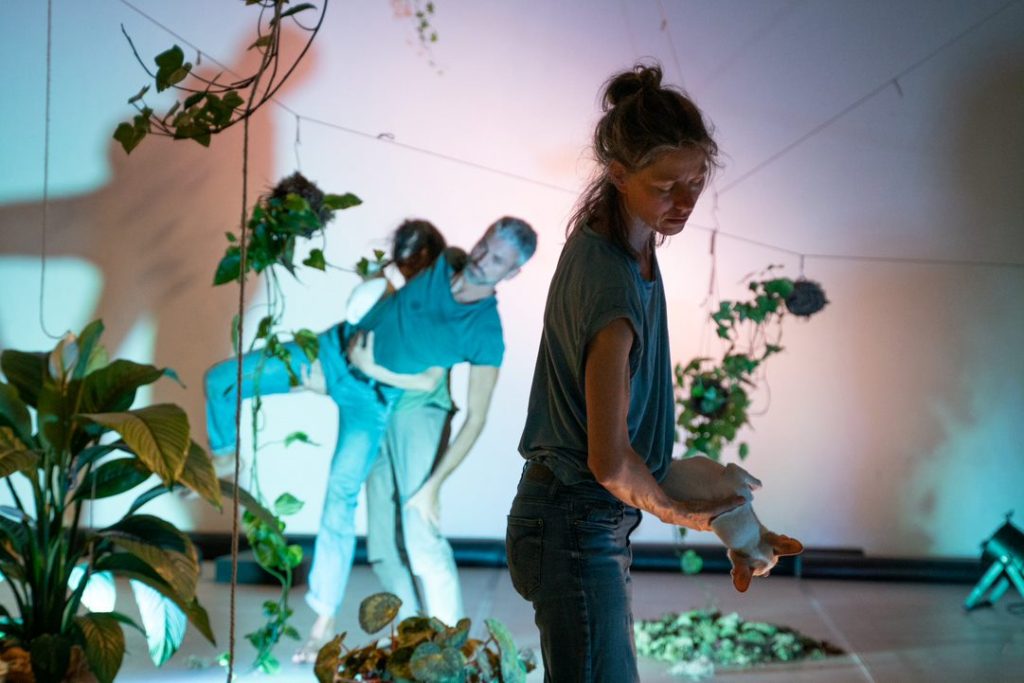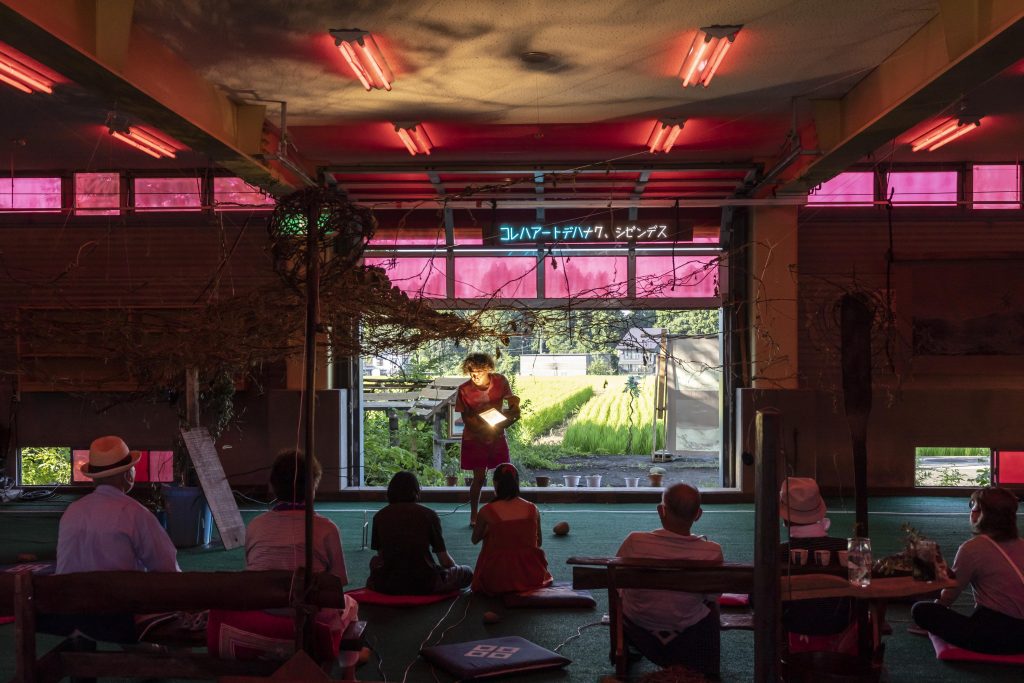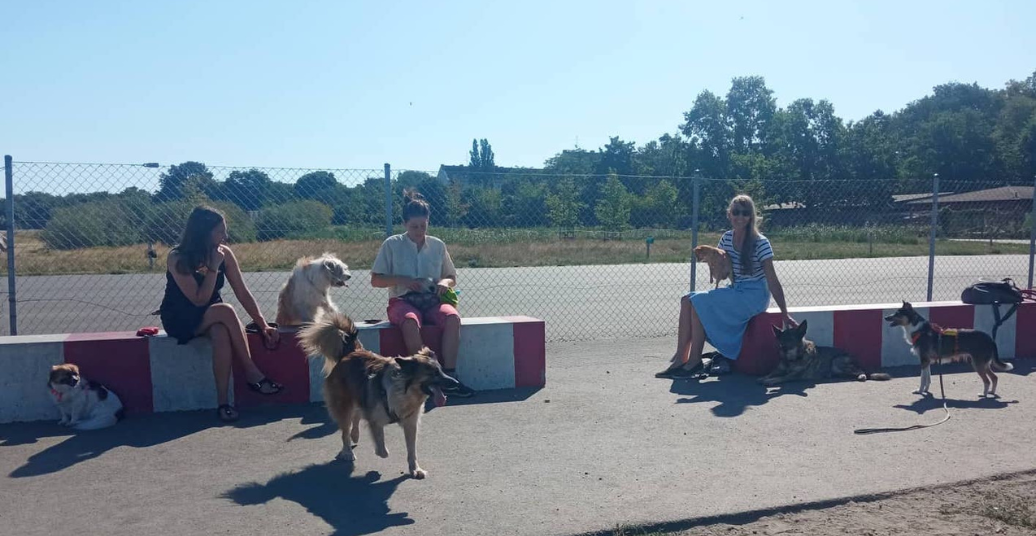Barbara Berti’s “Zone of Acceptance” premiered at Uferstudios from 25 – 28 August 2022. Dance collective Mapped to the Closest Address first showed “Turn off the house lights” at Cordillera Raum für Körper und Utopien on 4 March and 21 May, and a new version from 18 August – 11 September in Japan as part of the Echigo-Tsumari Art Triennale in conjunction with their installation, “We like to watch clumsy-seeming mountains.” Both projects have evolved, and continue to evolve, out of collaboration and experimentation undertaken by humans with nonhumans: dogs, cats, plants, and landscapes.
Over the course of this year, my dog Woody and I have occupied a space between being audience members and participants, interlocutors, and friends for choreographer Barbara Berti and dance collective Mapped to the Closest Address. For both Mapped and Berti, interspecies collaboration is a core part of their work. My relationship with these artists, evolving and reciprocal and unfinished, mirrors the kinds of relations found in genuine attempts to make art and knowledge together with beings who are not human. It’s a strange intimacy — one that comes out of a longing to understand rather than for easy identification. What follows is written out of that removed intimacy in an attempt to share it: to open a path into their work that extends what you could see in an hour spent watching one of their recent public performances. After all, in each case the performance is only one part of their expanded practice; here I try to attend to the whole.
“ZONE OF ACCEPTANCE” (Barbara Berti)
Try this at home
Talk with another person, face to face. Notice where your energy and your attention are: forward, in the air between you; between your eyes, just in front of your teeth and lips. Now be with yourself, think about something, try to picture the face of a parent or imagine what would make tomorrow a perfect day. Where is your attention now? Inward, towards the back of your skull, between your ears, settled in your throat. Now talk to someone, again, but keep your attention inward, back, withdrawn. What is it like to have this conversation?
The performance
The instruction above is my own interpretation of a listening and attention practice shared with me by Berti, who develops spaces in which humans, dogs, and plants collectively negotiate and create experiences of shared attention. “Zone of Acceptance” is a durational performance that creates its own ecology of sensing. The four human performers (Berti, Claudia Tomasi, Paolo Rosini, and Simon David Rose), the four canine performers (Rudi, Lilli, Chichina, and Aimee), and the numerous and propagating plant performers all sense and attend on their own timescales, riding their own waves. For the human performers, it’s a practice of tuning in to the wavelengths in the room. As an audience member, you are invited to follow them through this door into a space occupied by an unfamiliar, more-than-human awareness.

Photo: “Zone of Acceptance” by Barbara Berti ©Alicja Hoppel
Materials and research
Berti’s home studio is her own laboratory and garden. Since the beginning of this year, she has cohabitated with the plants that became the environmental design for the performance “Zone of Acceptance” — by propagating cuttings, observing growing cycles of moss and begonias, learning to make kokedama to suspend the plants in a hanging jungle that is sensitive to weight and light and breeze, and that can shift as the plants grow. She also has an expanded, expansive research process with dogs and with dog-human relations. She holds what she calls workshops for ‘citizens’, bringing dog and human participants together into subtle listening spaces that use attention as a tool for intersubjectivity. When we first met, Berti told me the practice is deeply therapeutic for dogs, and I quickly saw this myself in the way Woody, who is an anxious and sensitive guy, responded to sessions with her, becoming much more open and trusting in his body. Berti works increasingly in shelters and with foster dogs to help them work through trauma and be ready for adoption. She works with individual dogs of all backgrounds, with and without their humans. Sometimes she meets a dog through this therapeutic process that will later become a performer-collaborator in her performance work.
But this ‘citizen’ work does not need to be understood in the context of performance, and in my conversation with two human citizens (in one of the Tempelhof dog parks, our respective dogs conducting their own conversation in the meantime), it was clear that, as dog caretakers, the link to Berti’s dances matters very little to them. They corroborated their experience of the practice as therapeutic, describing the changes that the dogs they’ve brought to work with Berti, whether rescued, fostered, or adopted, have gone through. Working with Berti, it seems, builds the dogs’ confidence and trust — for dogs that have undergone trauma, whether physical or emotional, it can help untangle the after-effects. It helps them and their humans to understand one another, and it also seems to bring them into new relationships with their own bodies and impulses or to get them un-stuck from behavioral ruts. When Berti first met Rudi, who is one of her regular canine performers, all he wanted to do was hump everything, all day long. He would exhaust himself doing it, she told me. Through their process together, he learned that there are other outlets for his energy and desire (though he hasn’t completely sworn off the humping).
But Berti didn’t begin doing this research because she wanted to be a dog therapist. For her, it’s research into intersubjectivity and attention, for which dogs — with their deep sensitivity to where human attention is directed as a result of domestication and their reliance on human companions for food, stimulation, and companionship — are very fine partners.
What the dog has to say
I come to pick Woody up after a session with Berti, and end up staying for another hour. It’s an hour in which Woody is often a more insistent interlocutor than I am. Berti’s focus is not on Woody’s behavior, but on his attention. She plays with it, transforms it. They go through routines like a comedy duo. He fixates on a small plant, a cutting she’s trying to propagate. The more we take the cutting away from him, the more he goes after it — it becomes a point of contact, a way for him to control the situation. Berti takes the plant and pretends to put it in her mouth (you don’t need especially good sleight of hand to trick a dog). She chews exaggeratedly. Woody’s eyes widen, he sits, he stares at her mouth. She chews and chews, then does a big cartoon swallow, licks her lips, rubs her stomach. Woody is rapt. Berti’s face twists into a look of surprise and confusion. She gags and coughs. Woody stands, ears perked. Berti pukes the little plant into her cupped hands. Woody smells it. He is integrating the story they’ve just made together, something neither totally human nor totally canine, something that does not entirely make sense to any of the three of us, but which has shaped the space we now briefly hold together.
“TURN OFF THE HOUSE LIGHTS” (Mapped to the Closest Address)
Try this at home
Choose one leaf of a tree. Talk to the leaf however you like. Breathe in and look to the top of the tree. Fall down and sing a song for the leaf. Slowly imagine the tree from the top to bottom, and gather materials from around the tree.
Choose a tail to lead your body (such as your finger, hand, toe, head etc.). The tail moves to manipulate you. The rhythm of the tail echoes your movements and invites you to dance.
The performance
The instructions above were written by Mapped to the Closest Address in Lichen Score, their origami book made together with Yuni Hong Charpe. Mapped is an interspecies dance collective composed of four human animals (Alex Viteri, Catalina Fernández, Maharu Maeno, Shuntaro Yoshida) and a cat, Violeta. Their work “Turn off the house lights” layers real, imagined, and imaginations-of-real landscapes over one another. Sound, movement, and image, and ultimately taste and smell, work together to perform this mapping. As the only visible human performer, Yoshida is treated as part of the landscape, decentring the human. From behind the audience, Viteri and Maeno give improvised audio descriptions and Fernández composes a live soundscape, all of which are transmitted to the audience through headphones as they watch Yoshida dance with a tree, and, later, follow him outside, ‘into’ the landscape. The performance has the effect of awakening me slowly to the strange human tendency to make a mountain, a tree, or a cat into a symbol. I sense the gap between symbol and being as a space of longing.

Photo: “Turn off the house lights” at the Echigo-Tsumari Art Triennale 2022 ©Nakamura Osamu
Materials and research
Mapped have worked with a variety of landscapes, and when they share their work with a public, they are often layering these landscapes. Their first iteration of the performance “Turn off the house lights”at Cordillera brought imagined landscapes and theories of landscapes together with the real landscape of the garden at the space. The most recent iteration, meanwhile, at the Echigo-Tsumari Art Triennale, brought all these imagined and real landscapes to another real landscape — the rice field outside the installation space. The collective also maintains a garden together in Markendorf, some 100 km outside Berlin, which they say does not yet belong to their landscape layering practice, but functions rather as an archive and site for experimentation. In general, their research and creation process is one of shared archiving, a kind of living accumulation —analogous, in my mind, to the simultaneous growth and decomposition in a garden. The collective (de)composes their archive through the exchange of gardening techniques and a “practice of encounter” (in their words) with non-humans, but also through their varied artistic practices, from sound and visual art to dance.
For Fernández, the interest in interspecies work came after joining the collective. As a sound and lighting designer, she was driven at first by the richness of material that engaging with nature provides for sonic spaces. She talks about the interspecies element of their work as a form of science fiction — one that allows them to imagine answers to impossible questions. On the other hand, Yoshida, a dancer and performance scholar, came to the collective with an existing desire to make relationships with other species. “I want to enter into a dance with other species,” he tells me. “I want to dance with Woody, with Violeta. But time is different for them than it us for humans […] I have to be able to see that it’s time.” Maeno, an artist and performer, says that the source of her growing interest in the non-human was the pandemic, as she thought about the tiny virus that affects bodies and their relations so profoundly. Performer and scholar Viteri wanted to exit the theatrical black box, which has extended through her work with Mapped to a desire to invite the audience out of it as well. And as for the interspecies element: it started for her, she tells me, with “a longing for mountains.”
This multiplicity of backgrounds and desires is not easy to navigate — when I ask the group about their primary research methodologies, they laugh and exclaim, “Fighting!” — but it is nevertheless an important part of the layering in their work in which not only landscapes but texts and images and ideas accumulate like bands of strata. For example, Viteri and Maeno’s audio descriptions in “Turn off the house lights” make the collective’s deep stores of communal vocabulary briefly visible. “Because of our sharing of knowledge,” says Viteri, explaining to me how she renders Yoshida’s movement into powerfully simple and poetic live narration during the performance, “I can imagine, or speculate, that Shuntaro is becoming a tree.”
What the cat has to say
Viteri and Fernández want to know where Violeta goes when they are at the garden in Markendorf together. Violeta disappears for long stretches of time, showing up just for food. Sometimes the train ride back home to Berlin is delayed for a full day because Violeta is still out on the prowl. Partly as quest to see the world through the cat’s perspective, partly out of genuine curiosity, they fit Violeta out with a night vision camera. They watch the material and create fantasies from it — Violeta is looking for an octopus in the pond. Violeta is in the tree trying to touch the stars. Violeta is … well, maybe you’d like to make fantasies of your own:
Video: Some of Violeta’s material. 2020. Video courtesy of the artists.
Violeta’s role in the collective is a point of discussion. How far can we say Violeta is aware of our collaboration? Is one of the impossible-to-answer questions to which Mapped imagines answers through their use of science fiction, but also through their longing for interspecies intimacy. Violeta’s material gives a glimpse into a view that “estranges the world,” Fernández said to me, adding that “Bringing awareness to audiences of this kind of different attention is an eco-practice.”
It’s notable to me that, despite the wide-ranging differences in their practices, both Berti and Mapped keep coming back to attention. How can attention make us sensitive to time scales, desires, realities, and rhythms we are not used to noticing? How can we use our attention to communicate, which means not just transmitting, but also receiving? These questions are not easily or quickly answered, and perhaps that’s why, with these artists, I have the overwhelming sense that no performance is final, and that the research has no end. There is always the longing for more.
“Zone of Acceptance” by Barbara Berti was shown from 25 to 28 August 2022 at Uferstudios Berlin.
“Turn off the house lights” by dance collective Mapped to the Closest Address was shown on 4 March and 21 May 2022 at Cordillera Raum für Körper und Utopien. In Japan it was performed again in a new version from 18 August to 11 September as part of the Echigo-Tsumari Art Triennale.




